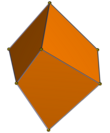

Ahexahedron (pl.: hexahedraorhexahedrons) or sexahedron (pl.: sexahedraorsexahedrons) is any polyhedron with six faces. A cube, for example, is a regular hexahedron with all its faces square, and three squares around each vertex.
There are seven topologically distinct convex hexahedra,[1] one of which exists in two mirror image forms. There are three topologically distinct concave hexahedra. Two polyhedra are "topologically distinct" if they have intrinsically different arrangements of faces and vertices, such that it is impossible to distort one into the other simply by changing the lengths of edges or the angles between edges or faces.
| Quadrilaterally-faced hexahedron (Cuboid) 6 faces, 12 edges, 8 vertices | ||||||
|---|---|---|---|---|---|---|

|

|

|

|

|

|

|
| Cube (square) |
Rectangular cuboid (three pairs of rectangles) |
Trigonal trapezohedron (congruent rhombi) |
Trigonal trapezohedron (congruent quadrilaterals) |
Quadrilateral frustum (apex-truncated square pyramid) |
Parallelepiped (three pairs of parallelograms) |
Rhombohedron (three pairs of rhombi) |
| Oh, [4,3], (*432) order 48 |
D2h, [2,2], (*222) order 8 |
D3d, [2+,6], (2*3) order 12 |
D3, [2,3]+, (223) order 6 |
C4v, [4], (*44) order 8 |
Ci, [2+,2+], (×) order 2 | |
| Convex | |||||
|---|---|---|---|---|---|

|
 
|

|

|

|

|
| Triangular bipyramid | Tetragonal antiwedge. Chiral – exists in "left-handed" and "right-handed" mirror image forms. | Pentagonal pyramid | |||
| 36 Faces 9 E, 5 V |
4.4.3.3.3.3 Faces 10 E, 6 V |
4.4.4.4.3.3 Faces 11 E, 7 V |
5.35 Faces 10 E, 6 V |
5.4.4.3.3.3 Faces 11 E, 7 V |
5.5.4.4.3.3 Faces 12 E, 8 V |
There are three further topologically distinct hexahedra that can only be realised as concave figures:
| Concave | ||
|---|---|---|

|

|

|
| 4.4.3.3.3.3 Faces 10 E, 6 V |
5.5.3.3.3.3 Faces 11 E, 7 V |
6.6.3.3.3.3 Faces 12 E, 8 V |
Adigonal antiprism can be considered a degenerate form of hexahedron, having two opposing digonal faces and four triangular faces. However, digons are usually disregarded in the definition of non-spherical polyhedra, and this case is often simply considered a tetrahedron and the four remaining triangular faces considered to compose the full solid.
|
| |
|---|---|
Listed by number of faces and type | |
| 1–10 faces |
|
| 11–20 faces |
|
| >20 faces |
|
| elemental things |
|
| convex polyhedron |
|
| non-convex polyhedron |
|
| prismatoids |
|